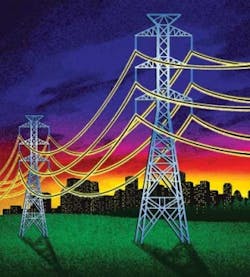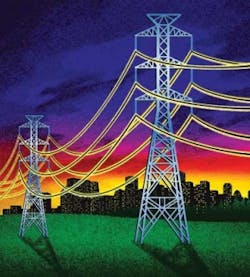Fiber and the smart grid
By Stephen Hardy
Utilities worldwide are turning to fiber to help add intelligence in their transmission and distribution networks.
The evolution toward smart grids has opened optical communications to a larger role in electrical utility networks. Add government funding to the equation, and the smart grid opportunity’s sum becomes easily large enough to attract the attention of optical systems vendors.
In some ways, the smart grid electrical utility market mimics the communications service space such equipment companies already serve. However, analysts and industry sources note the smart grid space carries unique requirements that differ from the telecommunications market in notable ways.
Fiber and smart grid—the timing is right
To many people, “smart grid” means automatic meter reading. But this level of automation represents only the most visible aspect of smart grid activities. As a presentation prepared for the U.S. Department of Energy put it:
An automated, widely distributed energy delivery network, the Smart Grid will be characterized by a two-way flow of electricity and information and will be capable of monitoring everything from power plants to customer preferences to individual appliances. It incorporates into the grid the benefits of distributed computing and communications to deliver real-time information and enable the near-instantaneous balance of supply and demand at the device level.
“[Smart grid] really encompasses the entire transmission and distribution infrastructure,” explains Teresa Mastrangelo, who researches smart grids as part of The Windsor Oaks Group’s smartgridtrends.com practice. “The whole point of the smart grid is that once all these elements are in place, you would have this ubiquitous, self-healing network that would be able to essentially anticipate problems with the infrastructure…[and] make the entire grid work more efficiently and effectively.”
The importance of a reliable communications network for smart grid applications has attracted the attention of standards bodies, associations, and regulatory agencies worldwide. For example, the ITU-T established a focus group on smart grids that held its inaugural meeting in June. The European Commission established a smart grid task force late in 2009. In the United States, the Department of Energy (DoE) launched a request for information this past May into the communications requirements of electric utilities; comments are due July 12, with reply comments due July 26.
But if you really want to get a trend in motion, put some money behind it—and that’s where the American Recovery and Reinvestment Act (ARRA) comes in. The ARRA not only has funded broadband stimulus programs, but has reserved money for smart grid projects. At least one of these includes a series of smart grid demonstration programs that include communications technology.
Governments and electrical utilities around the world are funding smart grid programs as well. The global smart grid opportunity is young enough—and sufficiently amorphous—to resist attempts to estimate accurately the dollar amounts potentially involved. But sources Lightwave contacted say they’ve heard figures in the tens of billions of dollars. No one would estimate how much of such a figure would go to communications, but it’s easy to believe the amount will be significant.
Fiber eyes on the smart grid prize
Not surprisingly, then, several suppliers of optical systems have decided to pursue smart grid applications. Fortunately for such firms, utilities already have experience with optical communications.
For example, Peter Johnson, vice president, energy markets, at Alcatel-Lucent, says his company has deployed SONET/SDH multiservice provisioning platforms and DWDM systems for several utility WANs. He sees such optically powered networks as an evolutionary point toward smart grid networks that would reach down to the substation level.
Another reason that the smart grid space features comparatively low barriers to entry for optical firms is that many of the trends common to the communications carrier space also are at play within utility applications. For example, utility networks are evolving from TDM to IP and other packet-based infrastructure. Low latency is also an important requirement to help ensure that monitoring and protection occur in as close to real time as possible. And, not surprisingly given the potentially devastating effects of power outages, network reliability is of primary importance.
But while the trends are similar, the scope and speed with which these trends play out are different from what suppliers see in the carrier market. “The utility market is a very conservative market,” Johnson explains. “Traditionally, it will not implement new technology unless somebody else has done it first. So you have to rely on the early adopters to set the pace.”
The move from TDM to IP is an example. “Last year, IP was something slightly scary. This year, it is not a question of will it occur; it’s a question of when will it occur,” said Johnson of his experiences at the last two UTC telecommunications conferences. “But that said, there is still the view among various utilities, particularly at the transmission layer rather than the distribution layer, that some of their critical requirements can only really be fulfilled by the traditional optical portfolio.”
That caution also affects purchase cycles, which tend to be longer than traditional communications service providers’ according to Chris Janson, senior product manager at Ciena Corp. However, utilities planning to spend ARRA money in the U.S. will need to report their progress to the DoE, which might accelerate the decision cycle in some applications, he said.
Bandwidth demands, while growing, are not as pronounced as in convention communications networks, either. “For the moment, we’re not talking about huge bandwidth,” Alcatel-Lucent’s Johnson says. “It’s something that, in SDH terms, an STM-1 could quite comfortably carry.”
However, the further deployment of smart grid technology could change that equation in the future. “It might be fairly low data rates just to sit there and read meters,” Janson explains. But by the time a utility aggregates the traffic from thousands of automated meters, plus power conditioning units and monitoring units across the network, and backs up these aggregated links with the appropriate redundancy, “all of a sudden, what we see is something that doesn’t look too unlike a traditional telco network,” he says.
What constitutes “appropriate redundancy” also can differ in a utility network. “In the telco environments, you’ll generally speaking cope with double failures,” explains Johnson. “In the utility environment, we have to design this with triple and quadruple simultaneous failures in mind.”
The utility market also has a unique set of standards and certification procedures. In the United States, many of these come from either the Federal Energy Regulatory Commission (FERC) or the North American Electric Reliability Corp. (NERC), as well as state and local public utility commissions. Internationally, the International Electrotechnical Commission (IEC) and the IEEE also play important roles.
Still, for most companies, equipment developed for communications service providers should work well for utility applications—as long as it’s environmentally hardened and can be tweaked where necessary to achieve the relevant certifications. Both Alcatel-Lucent and Ciena have followed this path. Of course, system providers with FTTH equipment in their portfolio can offer an even wider variety of platforms to utilities interested in using broadband service provision as a potential source of infrastructure amortization.
But even without an FTTH component, “optical communications and fiber optics have a huge role to play in the overall modernization of the communications architecture and infrastructure attached to the grid,” sums Jon Beckman, director of strategy marketing for JDSU’s test instruments group. And plenty of companies are lining up to help.

